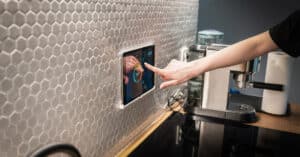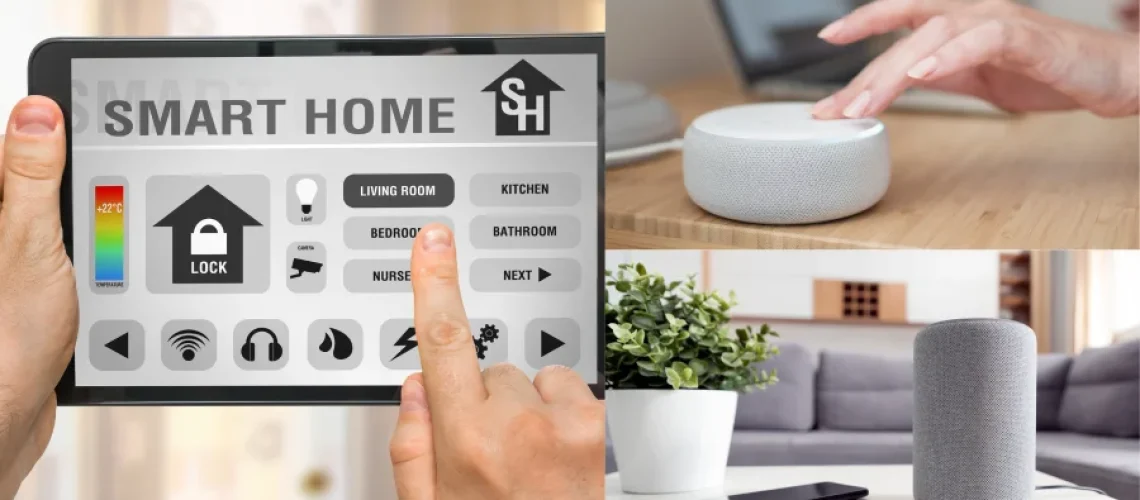
What Exactly is "Aging In Place"?
“Aging in place” is all about the wonderful possibility of older adults remaining in their own homes and communities safely, independently, and comfortably, no matter their age, income, or ability level. This beautiful concept centers on making sure the right services and supports are in place—like home modifications, health care, and community resources—so seniors can stay in their beloved, familiar surroundings instead of moving to assisted living facilities or nursing homes. Aging in place allows our seniors to enjoy a higher quality of life, hold onto their cherished independence, and stay connected with their social circles.
The Benefits of Smart Home Devices for Retirees
 As we get older, nothing matters more than feeling safe, comfortable, and independent in our own homes. Thankfully, advancements in smart home technology make this possible. Innovative devices and gadgets now help older adults maintain their independence, ensure their safety, and enhance their overall comfort. From voice-controlled assistants to automated security systems, there are countless smart home solutions tailored specifically for seniors.
As we get older, nothing matters more than feeling safe, comfortable, and independent in our own homes. Thankfully, advancements in smart home technology make this possible. Innovative devices and gadgets now help older adults maintain their independence, ensure their safety, and enhance their overall comfort. From voice-controlled assistants to automated security systems, there are countless smart home solutions tailored specifically for seniors.
In this article, we’ll explore the wonders of smart technology for elderly independence, discuss how these smart home devices contribute to senior safety, and delve into the various ways in which they enhance comfort for the elderly. So, whether you’re a senior looking to make your home smarter or a caregiver searching for ways to improve the living conditions of your loved ones, read on to discover how smart home technology can truly transform the way we age in place.
Embracing Smart Home Technology: Some Examples
 As technology continues to advance, it’s becoming clear that smart home devices aren’t just for the tech-savvy younger generations. Some of the new and innovative gadgets offer a multitude of benefits for retirees and older adults looking to simplify their daily lives and maintain their independence. Whether it’s monitoring health, increasing safety, or enhancing convenience, smart home devices are transforming senior living.
One of the most valuable smart home devices for retirees is the voice assistant. A common example of a voice assistant that you’ve like heard of is Amazon Dot or the Amazon Echo Show, otherwise known as “Alexa”. By using simple voice commands, seniors can easily manage tasks such as turning on lights, adjusting the thermostat, or making phone calls without having to move around or navigate complicated interfaces.
This intuitive technology is especially helpful for those with limited mobility or dexterity! That may not describe you at this moment, however we really are concerning ourselves with technology for aging in place. Meaning, we are trying to be forward thinking – setting ourselves up for an easier time of things if we do become less mobile in the future.
As technology continues to advance, it’s becoming clear that smart home devices aren’t just for the tech-savvy younger generations. Some of the new and innovative gadgets offer a multitude of benefits for retirees and older adults looking to simplify their daily lives and maintain their independence. Whether it’s monitoring health, increasing safety, or enhancing convenience, smart home devices are transforming senior living.
One of the most valuable smart home devices for retirees is the voice assistant. A common example of a voice assistant that you’ve like heard of is Amazon Dot or the Amazon Echo Show, otherwise known as “Alexa”. By using simple voice commands, seniors can easily manage tasks such as turning on lights, adjusting the thermostat, or making phone calls without having to move around or navigate complicated interfaces.
This intuitive technology is especially helpful for those with limited mobility or dexterity! That may not describe you at this moment, however we really are concerning ourselves with technology for aging in place. Meaning, we are trying to be forward thinking – setting ourselves up for an easier time of things if we do become less mobile in the future.  Health monitoring devices are another crucial aspect of smart home tech for senior living. These gadgets can track vital signs like heart rate, blood pressure, and sleep patterns, providing valuable information for both individuals and their doctors. This helps seniors stay on top of their health and detect any potential issues early. Additionally, some devices come with built-in fall detection capabilities, automatically alerting emergency services or family members in case of a fall, offering peace of mind for both the individual and their loved ones.
Health monitoring devices are another crucial aspect of smart home tech for senior living. These gadgets can track vital signs like heart rate, blood pressure, and sleep patterns, providing valuable information for both individuals and their doctors. This helps seniors stay on top of their health and detect any potential issues early. Additionally, some devices come with built-in fall detection capabilities, automatically alerting emergency services or family members in case of a fall, offering peace of mind for both the individual and their loved ones.
When considering top-rated smart home systems for seniors, comprehensive home security systems are very attractive if you can afford them. These systems include features such as motion sensors, door/window sensors, and security cameras, allowing retirees to feel safe and secure in their homes. With remote monitoring and notifications, seniors can stay informed of any unusual activity in real-time, even when they’re away from home.
Smart home devices truly do provide tremendous benefits for retirees and older adults. From the convenience of voice-controlled assistants to health monitoring and enhanced home security, these technologies are transforming the way seniors live and age in place. With the right selection of smart home devices, aging adults can enjoy a safer, more comfortable, and more independent lifestyle.
Check this link to see some specific examples and start to get familiar with the options as well as today’s price ranges.
TIP: Consider installing technology for aging in place now, whether for yourself or an elderly loved one. Delaying the purchase and installation could become problematic if you or your loved one later find yourselves unwilling or unable to handle the setup and installation tasks. By starting now, you can begin enjoying the benefits immediately and ensure a smoother transition into the future. Plus, early adoption allows for years of enhanced safety, comfort, and independence.
Enhancing Safety with Smart Home Technology
As technology continues to advance, our ability to ensure the safety and well-being of our ever growing senior population has never been greater. Smart home technology is transforming elderly safety, offering innovative solutions that empower seniors to live independently and securely in their own homes. With voice-controlled systems and senior-friendly upgrades, caregivers and loved ones can finally have peace of mind knowing their elderly family members are protected.
My Experience: When my in-laws chose to retire far from us, my father-in-law, now 88, found himself living alone without family nearby after my mother-in-law passed away. However, he took matters into his own hands, embracing technology to ensure his safety and well-being. With alarms in place to alert us of any falls or changes in his blood sugar levels, he single-handedly adopted these innovations, surprising us with his initiative and the invaluable support they provided us all. As “the family” overseeing his care, his proactive approach to leveraging technology not only eased our worries but also highlighted the power of self-reliance in maintaining independence, even across distances.
 One of the standout benefits of smart home technology is real-time monitoring and assistance. Smart surveillance cameras and sensors can be strategically placed throughout the home, alerting caregivers to any unusual activity or emergencies. For example, if an elderly person falls, smart sensors can detect the sudden movement and automatically send an alert to a designated contact. This immediate response can save lives and prevent further injuries.
One of the standout benefits of smart home technology is real-time monitoring and assistance. Smart surveillance cameras and sensors can be strategically placed throughout the home, alerting caregivers to any unusual activity or emergencies. For example, if an elderly person falls, smart sensors can detect the sudden movement and automatically send an alert to a designated contact. This immediate response can save lives and prevent further injuries.
Voice-controlled home systems are another game-changer for senior safety. These systems allow seniors to manage various aspects of their homes, including lighting, temperature, and security, simply by using their voice. This eliminates the need for physical exertion or dealing with complicated technology interfaces, making it much easier for seniors to navigate their living spaces. Additionally, voice-controlled systems can be integrated with emergency call buttons, providing immediate access to emergency services in case of a medical or safety-related incident.
 Senior-friendly smart home upgrades also offer peace of mind by addressing common safety concerns faced by elderly individuals. These upgrades can include brighter lighting systems, grip bars, and non-slip flooring to reduce the risk of falls and accidents. Smart appliances, such as stove sensors and automatic shut-off valves, can help prevent kitchen-related accidents. (How amazing is this for those families who have a loved one with dementia!) By implementing these upgrades, homes can become safe havens where the elderly can maintain their independence while minimizing potential dangers.
Senior-friendly smart home upgrades also offer peace of mind by addressing common safety concerns faced by elderly individuals. These upgrades can include brighter lighting systems, grip bars, and non-slip flooring to reduce the risk of falls and accidents. Smart appliances, such as stove sensors and automatic shut-off valves, can help prevent kitchen-related accidents. (How amazing is this for those families who have a loved one with dementia!) By implementing these upgrades, homes can become safe havens where the elderly can maintain their independence while minimizing potential dangers.
Smart home technology is revolutionizing elderly safety by providing solutions that cater to the specific needs of seniors. From real-time monitoring and assistance to voice-controlled home systems and senior-friendly upgrades, technology is empowering the elderly to live independently and confidently in their own homes. As more advancements are made, smart home technology will continue to enhance the safety and well-being of our beloved elders, ensuring they can age gracefully and securely.
Smart technology has become a beacon of hope for those wishing to age gracefully in the comfort of their own homes, shielding them from the incessant pressure to relocate to nursing homes or assisted living facilities. By incorporating advanced monitoring systems, automated assistance, and real-time alerts, smart devices empower individuals to maintain their independence while providing reassurance to concerned family members.
These innovations not only enhance safety and security but also preserve dignity and autonomy, allowing seniors to thrive in familiar surroundings without feeling like a burden or losing their sense of freedom. As a result, smart technology serves as a silent guardian, enabling aging individuals to live on their own terms while alleviating the need for constant intervention or supervision from loved ones.
Increasing Comfort through Smart Home Innovations
As technology keeps advancing, our homes are evolving too. With just a voice command, we can adjust the lighting, control the temperature, and even automate household chores – such as robot vacuums!! These advancements are not only changing how we experience comfort but are also catering specifically to the needs of the elderly, revolutionizing the way they age comfortably.
 One major advantage of smart home technology for seniors is the added safety and security it provides. Devices like smart door locks, security cameras, and motion sensors offer peace of mind, helping prevent accidents and creating a secure living environment. For instance, these gadgets can alert family members or caregivers if something seems wrong, such as a door left open or a fall detected, enhancing the overall well-being of seniors.
One major advantage of smart home technology for seniors is the added safety and security it provides. Devices like smart door locks, security cameras, and motion sensors offer peace of mind, helping prevent accidents and creating a secure living environment. For instance, these gadgets can alert family members or caregivers if something seems wrong, such as a door left open or a fall detected, enhancing the overall well-being of seniors.
Moreover, smart home tech simplifies daily tasks for the elderly by automating them. Activities like adjusting lights or the thermostat can become challenging with age, but with smart switches and voice-controlled systems, seniors can manage their surroundings effortlessly. This not only boosts comfort but also fosters a sense of independence and empowerment.
Additionally, smart home devices for elderly care include medical monitoring tools and assistance features. Wearable devices track health metrics, while smart pill dispensers offer medication reminders, making it easier for seniors to manage their health. These systems can also be linked with emergency response services, ensuring immediate help during medical emergencies.
In essence, smart home innovations are reshaping our lives and are especially beneficial for seniors. By enhancing safety, automating tasks, and improving medical care, these devices significantly enhance comfort and quality of life for the elderly. As technology progresses, it’s essential that we embrace these solutions to promote the well-being and comfort of our aging population.
Embracing Independence: How Smart Home Solutions Empower Seniors
 In recent years, smart home innovations tailored for seniors have been gaining traction. These cutting-edge devices and systems are purposefully crafted to elevate the quality of life for older adults by creating safe and comfortable living spaces. With features like automated lighting, temperature control, and advanced security systems, managing the home environment has never been easier—all accessible through a smartphone or simple voice commands.
In recent years, smart home innovations tailored for seniors have been gaining traction. These cutting-edge devices and systems are purposefully crafted to elevate the quality of life for older adults by creating safe and comfortable living spaces. With features like automated lighting, temperature control, and advanced security systems, managing the home environment has never been easier—all accessible through a smartphone or simple voice commands.
Among the most notable advancements in smart home technology are the introduction of smart assistants designed specifically for seniors. Devices like Google Home or Amazon Echo serve as invaluable companions, aiding in daily tasks, providing medication reminders, and scheduling appointments. With a mere voice command, seniors can effortlessly control their environment, make calls, enjoy music, or even seek recipe suggestions.
Yet, the benefits of smart home tech for seniors extend far beyond mere convenience. These innovative solutions instill a sense of security, offering peace of mind as seniors navigate their homes. Moreover, they facilitate meaningful connections with loved ones, enabling video calls and remote check-ins through smart cameras. Through personalized setups and assistance, smart home technology truly empowers seniors to age comfortably in their own homes.
 In essence, the era of smart home technology has ushered in a new chapter of independence for seniors. With tailored innovations and intuitive assistants, older adults gain greater control over their living spaces and daily routines. These tech-driven solutions not only enhance convenience but also foster security and connection, enabling seniors to embrace aging in place with confidence and dignity.
In essence, the era of smart home technology has ushered in a new chapter of independence for seniors. With tailored innovations and intuitive assistants, older adults gain greater control over their living spaces and daily routines. These tech-driven solutions not only enhance convenience but also foster security and connection, enabling seniors to embrace aging in place with confidence and dignity.
Drawbacks and Considerations of Smart Home Technology for Seniors
While smart home technology offers a wealth of benefits for seniors seeking to maintain independence and live comfortably at home, it’s important to consider some potential drawbacks and practical limitations. Here are some key points to keep in mind:
- Cost: Smart home devices and systems can range from relatively affordable to quite expensive. Installation fees and ongoing subscription costs for monitoring services can add up. This can be a barrier for seniors on a fixed income.
- Technical Complexity: Setting up and using some smart home devices can be challenging, especially for those unfamiliar with technology. Complex interfaces and troubleshooting issues can lead to frustration and discourage adoption.
- Privacy Concerns: Smart home devices often collect data on user activity and movements. Seniors may be concerned about data privacy and security, especially with regards to sensitive health information.
- Limited Dexterity or Vision: For seniors with limited mobility or vision, manipulating small devices or navigating touchscreens can be difficult. Choosing user-friendly interfaces with large buttons and voice control options is crucial.
- Social Isolation: While smart home technology can connect seniors to loved ones and emergency services, it’s important to ensure it doesn’t replace human interaction. Socialization and emotional well-being are vital for healthy aging, so strike a balance between tech and traditional forms of connection.
- Reliability and Dependence: Smart home technology relies on a stable internet connection and can malfunction. Seniors may become dependent on these systems, and outages or technical difficulties could disrupt their daily routines.
Addressing the Drawbacks:
- Research and Compare: Carefully research different smart home products and choose user-friendly options with clear instructions and readily available customer support.
- Start Small: Introduce smart home technology gradually, focusing on devices that address specific needs and interests. This allows for a smoother learning curve for seniors.
- Seek Help with Setup: Consider involving family members, friends, or tech-savvy professionals to help with installation and initial setup. This can alleviate frustration and ensure proper configuration.
- Focus on Functionality: Prioritize devices that solve real problems and make daily tasks easier for the senior. Don’t get overwhelmed by the latest gadgets; focus on practical benefits.
- Maintain a Balance: Smart home technology should complement, not replace, human interaction. Encourage social interaction and traditional forms of connection to combat potential social isolation.
By acknowledging these drawbacks and taking proactive steps to address them, you can make informed decisions about incorporating smart home technology for aging in place.
The goal is to become empowered to live independently and comfortably for as long as possible, while keeping specific needs and limitations in mind.

A Closer Look at Technology for Aging in Place
Staying independent and living comfortably at home becomes a priority for many seniors. Smart home technology and wearable tech offer innovative solutions to enhance safety, convenience, and overall well-being. Here’s a breakdown of some popular categories and their benefits for seniors:
1. Smart Home Devices:
- Smart Speakers & Displays (Price Range: $50 – $200):
- Offer voice control for lights, thermostats, and calls.
- Play music, answer questions, and set reminders.
- Devices with screens (e.g., Echo Show, Nest Hub) allow video calls and visual information display, helpful for those with limited mobility or vision.
- Smart Lighting (Price Range: $10 – $50 per bulb):
- Voice-controlled dimming, color changing, and scheduling for improved safety and convenience (e.g., Philips Hue, LIFX).
- Smart LED Night Lights offer automatic or voice-controlled illumination for nighttime navigation (e.g., Leviton, GE).
- Smart Thermostats (Price Range: $100 – $300):
- Self-learning thermostats automatically adjust to preferences for energy savings and comfort (e.g., Nest Learning Thermostat, Ecobee Smart Thermostat).
- Smart Radiator Valves offer room-by-room temperature control (e.g., Moes, Honeywell).
- Smart Home Security Systems (Price Range: Varies):
- DIY systems with various sensors, cameras, and base stations for comprehensive home monitoring (e.g., SimpliSafe, Ring).
- Smart Door Locks with keypad or voice control eliminate physical keys and allow remote access control (e.g., Schlage, Yale).
- Smart Smoke and Carbon Monoxide Detectors provide real-time alerts and integrate with other smart home devices for a comprehensive safety system (e.g., Nest Protect, First Alert).
2. Wearable Tech with Medical Applications (Price Range: $200 – $500):
- Smartwatches (e.g., Apple Watch, Samsung Galaxy Watch):
- Offer fall detection, emergency SOS calling, and health monitoring features (heart rate, blood oxygen).
- Medical Alert Wearables:
- Go beyond smartwatches with features like medication reminders, fall detection with built-in help buttons, and GPS tracking for added safety (e.g., Bay Alarm Medical, Mobile Guardian).
- Health and Safety Devices (Price Range: Varies):
- Fall Detection Systems (e.g., Medical Alert Systems) use wearables or in-home sensors to detect falls and trigger emergency alerts. Prices vary depending on service plans and features.
- Medication Reminder Systems (e.g., TabSafe, MedMinder) help seniors stay on track with medication schedules.
- Automatic Medication Dispensers (e.g., Med-Cafe, PillPack) dispense medications on schedule, eliminating missed or double doses (requires prescription and service fees).
- Smart Scales (e.g., Withings, Wyze) track weight and body composition, sending data to a smartphone app for monitoring health trends.
- Blood Pressure Monitors (e.g., Omron, Welch Allyn) allow for easy, at-home monitoring and data storage for doctor consultations.
Additional Smart Home Products:
- Smart Plugs (Price Range: $20 – $50): Control lamps, appliances remotely using a smartphone or voice commands (e.g., TP-Link, Kasa).
- Smart TVs (Price Range: Varies): Voice control, streaming services, and easy access to photos and videos for entertainment and connection (consider user-friendliness for seniors).
- Smart Kitchen Appliances (Price Range: Varies): Voice-controlled coffee makers, refrigerators with grocery monitoring, or smart ovens may simplify tasks for some seniors.
- Smart Vacuum Cleaners (Price Range: $200 – $1000): Robot vacuums can keep floors clean with minimal effort, ideal for seniors with mobility limitations (e.g., iRobot Roomba, Shark IQ Robot).
- Smart Environmental Monitors (Price Range: Varies): These devices can monitor air quality, water leaks, and even mold growth, helping seniors maintain a healthy and safe home environment (e.g., Airthings, LeakSmart).
Choosing the Right Technology:
- Consider the senior’s technical comfort level and specific needs.
- Focus on functionality: prioritize devices that solve real problems and make daily tasks easier.














